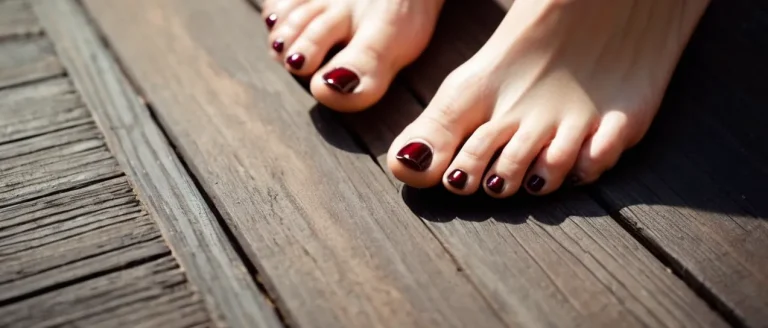Does Nail Polish Remover Remove Paint? A Detailed Look
Whether you’re looking to remove an accidental paint spill or change the color on a painted surface, you may be wondering if you can use nail polish remover to strip away layers of paint. With many households having bottles of nail polish remover on hand, it can seem like an easy solution.
But can you really use nail polish remover to remove paint effectively? Let’s take a detailed look at whether this nail salon staple can also work wonders on your painted walls, furniture, or other surfaces.
If you’re short on time, here’s a quick answer: Nail polish remover can remove paint, but it’s generally not the most effective option. While it may work for cleaning up small spills or paint drips, using nail polish remover to strip paint from large surfaces can be time-consuming and may not give the best results.
What Is in Nail Polish Remover?
Acetone
The primary ingredient in most nail polish removers is acetone, which makes up 50-100% of the solution. Acetone is an effective solvent that breaks down the nail polish and allows it to be wiped away easily.
It works by dissolving the chemicals that hold the pigments and polymers of nail polish together. However, acetone can be drying and damaging to skin and nails with frequent use. That’s why some removers also contain moisturizing ingredients like glycerin.
Acetone is found in removers labeled as “100% acetone” or “acetone based”. These are the strongest types of nail polish removers. They provide maximum dissolving power to easily take off multiple layers of color, glitter polishes, and long-lasting gel manicures.
The higher the acetone concentration, the quicker it can break down polish. 100% acetone removers are ideal for salon use when removing polish from many clients.
Other Ingredients
Besides acetone, nail polish removers can contain other solvents and ingredients:
- Ethyl acetate – an alternative dissolving agent derived from ethanol
- Isopropyl alcohol – added for its drying and disinfecting properties
- Propylene carbonate – a milder solvent that is less drying than acetone
- Glycerin – draws moisture into nails and cuticles to prevent dryness
- Vitamin E – helps condition nails and skin
- Fragrance – gives a pleasant scent
- Thickening agents – adjust the viscosity of the remover
Non-acetone removers contain a mixture of these ingredients to dissolve polish with less impact on the nails. These are gentler options marketed as “nourishing”, “moisturizing”, or “strengthening” formulas.
They usually take a little longer to remove polish but can be better for those with dry, fragile nails.
Some nail polish removers are designed just for glitter polishes, which contain more pigment. These may use Cellulose Acetate Butyrate to cling to glitter particles and lift them away.
How Nail Polish Remover Removes Nail Polish
Breaks Down Nail Polish
Nail polish removers work by breaking down the chemical bonds that hold the pigments and polymers of nail polish together (1). The main active ingredient in most nail polish removers is acetone, a harsh solvent that can dissolve substances like nail lacquers.
When applied to painted nails, acetone penetrates through the layers of polish and attacks the carbon-carbon bonds and ether linkages which give the lacquer its color, shine, and adhesive properties.
As these connections come undone, the once durable polish loses integrity and breaks down into smaller molecules. These fragmented components no longer maintain the qualities needed to cling to nails or retain a glossy appearance.
The polish loses coherence, becomes soluble in the acetone, and separates from the nail surface – allowing easy removal with gentle wiping. Though harsh on nail color, acetone generally leaves natural nails unaffected.
Allows Easy Removal
In addition to breaking molecular bonds, nail polish removers help lift lacquer from nails through simple solvent action. As a volatile, fast-drying liquid, acetone can quickly soften and dissolve the nail polish layers (2).
The remover penetrates below the polish and causes the layers to swell and expand slightly. This decreases adhesion to the nail and enables the product to be swiped or rubbed off with little effort.
Removal is further eased by acetone evaporating from the remover solution. As the volatile solvent leaves the liquid, it takes fragments of dissolved polish along with it. This helps strip color from the nail in tiny pieces without the need for harsh scrubbing.
Between chemical breakdown and physical removal of polish debris, nail lacquer can be effectively eliminated.
References:
Using Nail Polish Remover to Remove Paint
Can Work on Small Paint Spills
Nail polish remover containing acetone can be quite effective at removing small, fresh paint spills from surfaces. The acetone acts as a solvent, breaking down the paint so it can be more easily wiped away.
For a recent mishap involving a tipped over paint can or brush strokes in the wrong spot, a bit of nail polish remover on a cotton ball may get the surface looking as good as new.
Not Ideal for Large Surfaces
Attempting to remove paint from a large surface using nail polish remover would likely be frustrating and damaging. Generously covering a wall or piece of furniture with acetone is not practical. The amount of rubbing and wiping involved would be exhausting and probably less effective than other paint removal methods.
Using too much nail polish remover may also damage some surfaces.
Multiple Applications May Be Needed
When using nail polish remover for paint removal, one application often won’t completely get rid of the paint. Plan on gently wiping with nail polish remover a few times, allowing the acetone to soak into the paint between wipes. Slowly and patiently work at the paint stain until it has disappeared.
Rushing the process with vigorous rubbing can damage some surfaces.
May Damage Some Surfaces
While nail polish remover can eliminate paint from resilient surfaces like metal, tile, or sealed wood, using it on more delicate materials may do harm. Surfaces like raw wood, natural stone, and fiberglass may end up with damage or discoloration if exposed to nail polish remover.
Test nail polish remover on an inconspicuous part of the surface first to check if any negative reactions occur. Safer paint removal methods are recommended for delicate or porous finishes.
More Effective Paint Removal Options
Paint Strippers
Paint strippers are chemical solutions formulated to detach layers of paint from surfaces. They work by dissolving the adhesion between the paint and the underlying surface, allowing the paint to be more easily scraped or scrubbed off.
Common active ingredients in paint strippers include methylene chloride, N-methyl-2-pyrrolidone (NMP), dibasic esters (DBE), acetone, toluene, xylene, methanol, and ethanol. These solvents can be dangerous if improperly handled, so it’s important to follow all safety instructions when using paint strippers.
According to research on the EPA’s website, methylene chloride based strippers are the most effective at removing multiple layers of paint quickly. However, they also emit toxic fumes and can irritate skin and eyes.
Safer alternatives like DBE and NMP based strippers work almost as well but take longer. For best results, apply a thick coat of stripper and wait the recommended time listed on the product before scraping off with a putty knife. Multiple applications may be needed for many layers of paint.
Sanding
Sanding uses abrasive paper or abrasive pads to literally grind away the top layer of paint mechanically. It allows for removal of paints and finishes without any chemicals but requires physical effort.
Begin with a coarse 60-80 grit sandpaper to remove bulky paint, then switch to finer 120-150 grit to smooth the surface for repainting.
While sanding produces no hazardous fumes or wastes like other methods, it does create lots of dust that necessitates wearing respiratory protection. Vacuuming up dust and debris frequently is recommended. Sanding can also be very labor intensive for removing many layers of paint.
Power sanders help speed the process but are noisy and vibrate a lot during prolonged use according to familyhandyman.com.
Heat Guns
Heat guns use hot forced air, much like a powerful hair dryer, to soften and blister multiple layers of paint so they can be more easily scraped off surfaces. Temperatures can range from 200 to over 1000 degrees Fahrenheit.
Higher heat allows paint to be removed faster but also increases the risk of scorching or igniting the wood underneath if kept in one place too long.
Consumer Reports recommends starting on a lower temperature setting around 500-600°F and keeping the heat gun 6-8 inches away from the surface to avoid damage. Have a spray bottle of water and wet rags ready to quickly extinguish any small fires.
Heat guns generate significant fumes so be sure to wear respiratory protection and work in a well-ventilated area. The high initial cost of a professional heat gun ranges from $80 to $150 but provides effectiveness and control unmatched by DIY heat methods like blowtorches and open flames according to This Old House.
Pressure Washers
Pressure washers utilize an electric or gas powered motor to generate high water pressures up to 4,000 PSI. They can be very effective for removing thick, loose paint from surfaces including brick, concrete, aluminum siding, fences, decks, and other solid materials that won’t be damaged by the intense water pressure.
For comparison, statistics shared on PressureWashr show that 2,000-3,000 PSI works well to strip paint and stain from wood surfaces while more delicate tasks like washing a car only require 1,400-1,800 PSI.
Wear protective equipment to shield bare skin from painful debris ejected by the powerful water stream. Rental costs for heavy duty gas pressure washers capable of paint removal average around $45-$65 per day.
Safety Tips When Using Nail Polish Remover
Work in a Well-Ventilated Area
When using nail polish remover, it’s crucial you work in a room with good airflow and ventilation. Most nail polish removers contain acetone, which emits strong fumes that can be hazardous if inhaled in an enclosed space.
Opening windows, turning on fans, or going outside creates air circulation so fumes disperse instead of concentrating around you. This precaution greatly reduces health risks like dizziness, headaches, and nausea from inhaling chemicals.
Wear Gloves and Eye Protection
Exposing your skin and eyes to nail polish remover can cause irritation, redness, and discomfort. Wearing nitrile gloves prevents the acetone and other chemicals from drying out your hands. Similarly, safety goggles protect your eyes if droplets splash while pouring remover or rubbing off polish.
You can buy affordable gloves and goggles from any hardware store or online retailer. Protecting yourself with this equipment is a small inconvenience that saves a lot of pain!
Rinse Surfaces Thoroughly After Use
Once you finish removing nail polish with acetone, be sure to wash any tables, sinks or other surfaces thoroughly with soap and water. Traces of chemicals left behind can be harmful if transferred to food, drinks, skin, etc. Rinsing prevents indirect exposure from remnant nail polish remover.
An extra few minutes removing all residues guarantees everyone’s safety. For extra protection, consider working over a washable mat or tray that’s easy to clean afterwards.
Keep Out of Reach of Children & Pets
Like most household chemicals, it’s critical to store nail polish remover securely out of reach of kids and pets. Ingesting or even handling the wrong way can make them sick. Keep remover locked up high in a cabinet they cannot access even if climbing on furniture.
Never transfer it to an unlabeled container they may mistake as safe. Following this rule is non-negotiable for their well-being. Adults should also use care when handling remover themselves to set a good example!
Conclusion
While using nail polish remover to strip paint may seem like a quick and convenient solution, it comes with some drawbacks. For large surfaces, you’ll get better results faster by using a commercial paint stripper, sander, or other more heavy-duty option.
However, if you’re dealing with a small paint spill or drips on a non-porous surface, nail polish remover can be effective. Just be sure to take appropriate safety precautions. With the right technique and realistic expectations, nail polish remover can be an acceptable option for minor paint removal jobs.







